- Bernard Preston homepage
- Yellows
- Growing Butternut Squash
Growing Butternut Squash
Growing butternut squash is not difficult, but they have a long season, so in the far northern climes, it's best to plant them in a seed box, kept indoors at night until all signs of frost are over.
Plant them out in the garden in early April. In sunny South Africa we drop the seeds directly into the ground in September.
This page was last updated by Bernard Preston on 15th November, 2021.
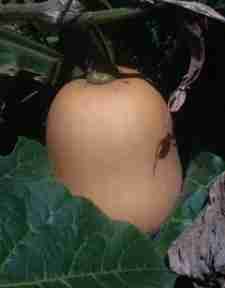
American plant-breeder, Charles Leggett, credited with the butternut, was of the opinion there wasn't a decent tasting pumpkin big enough to feed the whole family; I hope he took out a patent on this most excellent fruit.
Having lived in the States for four years I have to agree that their pumpkins are only fit for Halloween and hog-food. You have to dicky them up with so much sugar to make them palatable, but butternut squash are naturally sweet.
They also contain a substantial amount of vitamin C which is one of the reasons it stimulates and balances the immune-system; one cup will supply a quarter of your daily requirements.
If you are a baker a dollop of butternut-soup in the bread-dough adds so much to the flavour and texture of the loaf.
- Bernard Preston homepage
- Yellows
- Growing Butternut Squash
So in warmer climates, simply plant them directly in the ground in the spring. The seeds are quite large so set them fairly deep, perhaps an inch, and gently compact the soil.
If you throw raw waste from the kitchen, which you should unless there is vermin, onto your compost pile then the plants will come up in the heap, and take it over if you leave them there; usually I transplant some of the seedlings.
But those growing directly in the compost heap are the tastiest of them all.
It's good to follow your butternut with a legume crop like green beans; they fix nitrogen ensuring a beautiful harvest. I grow the bush variety mainly for this fertilizing of the soil; it is a hassle to reap them, taking much longer and you will probably put your back out. The pole kind are far more prolific and friendly but not easy to grow in the middle of your beds.
You do need a large vegetable garden for any of the pumpkin family; they take over and will come creeping in your back door if you're not careful.
Growing butternut squash are prolific feeders
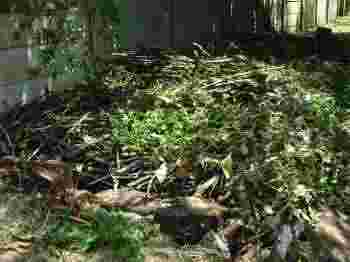
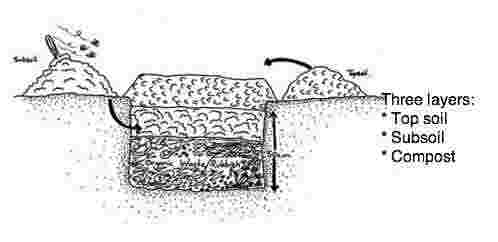
To get a decent crop when growing butternut squash it is best to dig out a small trench and fill it with well-rotted manure, vegetable cuttings and grass clippings; rotting sticks, compost and waste from the kitchen too. Eggshells, potato peels and tea leaves are all fine.
In fact, well ahead of time, I choose the site for growing butternut squash, dig out a trench, and use it as a compost heap, covering the vegetable waste lightly with soil periodically; it has to breathe. Then in spring all is ready.
Or alternatively use a compact compost tumbler if you require only a limited amount.
Composting with sticks and logs is also a good option if you have a larger garden.
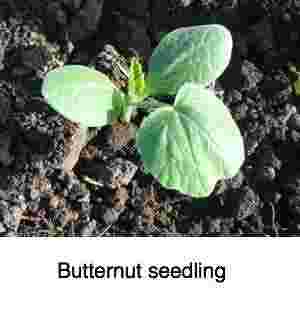
Plant 6-10 seeds out, and weed out the weaker seedlings. Keep back a few, more than adequate for the average family. Or they will take over your whole garden.
Butternut tends to be untidy, seeking out the sun, so you can grow it up a fence, on netting, but we just let it meander, and move the tendrils when it heads for other seed beds.
One joy is that growing butternut squash keeps the weeds under control; here are ours competing with sweet potatoes and, unseen, a crop of bush beans. Those we might reap, or just leave them for their nitrogen fixation bacteria. Notice the vibrant green leaves; that is nitrogen for you from the beans.
Roses and peppadews can be seen in the background.
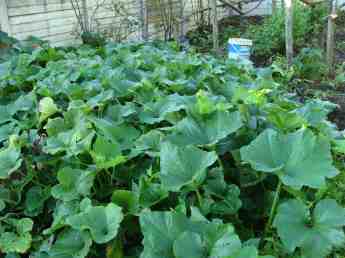
Or, if you have a small garden that must be kept tidy grow your butternut squash on a stand or fence.
Can you see what is hiding in that rampant vine? It is large, well over a foot long, and still very green; it will fill out and turn butternut-orange in another month or two.
It is late summer here and, for our vitamin A we are enjoying zucchinis and gemsquash; less rich but still excellent.
We love the variety that growing butternut squash, along with all these cousins brings to our dining room table.
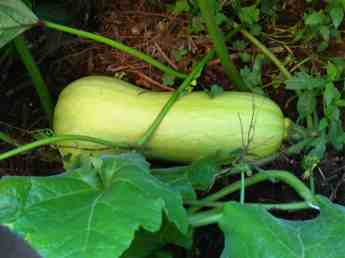
Growing Butternut Squash: Reaping the fruit
Growing butternut squash has a long season. Be patient, dreaming of the easy soups that you will enjoy in the fall and winter. Wait until the leaves and stalks die back, and the fruit turns a deep orangey-brown before reaping. The skin will be quite hard. If you pick them too soon they are insipid and will not keep through the cold months.
You need quite a strong kitchen-implement to remove the skin; more about that later.
They
are pollinated by insects; bees especially love the flowers for the bright-yellow pollen. Avoid
using insecticides, they don't get badly stung because of their hard skins. In fact, neonics need to be banned from the planet.
Here is perhaps a crazy idea; have you ever thought of having a few hives in the garden? Introduced to the joys of raw honey by my grandfather, beekeeping competes seriously with gardening, gliding, and writing the Bernard Preston books for my favourite hobby.
Nothing,
absolutely nothing, can compete with your own fresh, raw unheated
honey on your rolled-oats porridge in the morning; with a dollop of butter, of course. No one enjoying these treasures regularly from the garden needs to worry about cholesterol.
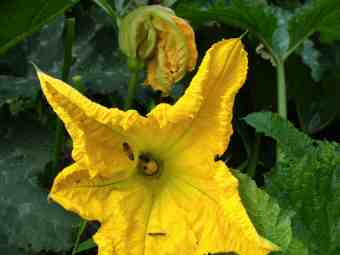
This chappy isn't quite ready. The colour is still a bit greenish, wait
for it to turn a light brownish hew; when all the leaves and stems
have died back. These stems are still green. However, they may get burnt without the leaves to shade them, if the sun is still fierce.
Pick them too soon and they taste rather insipid. Wait too long and the vervet monkeys will steal ours, or rats hollow them out.
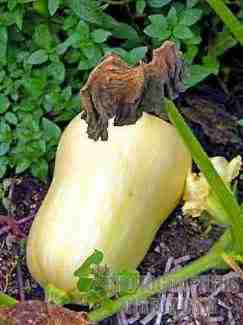
Now he's ready to reap. Notice the leaves dying back and the stem to the fruit will start to dry out. It is time to hunt out that easy recipe for butternut squash soup.
This year we've planted sweet potatoes for the first time. Together with butternut and you have the very best easy squash soup recipe.
Biological Nitrogen Fixation
In order to grow monster delicious butternuts like these for your Easy Butternut Squash SOUP you also need to think about crop rotation. These butternut followed a crop of pole beans. Legumes have the unique property of attracting nitrogen fixation bacteria that have the ability to fix the atmospheric gas; something farmers pay billions for. Prolific plants need the element.
You will notice that whatever crop you grow after legumes like favas, particularly if you know about starting a compost pile, will be prolific beyond your wildest dreams. Tonight it's green beans and butternut soup.
Low fat, high protein menus
Here is one last thought; if you are dieting (did you know that more people die on planet Earth from obesity than starvation?) then pole beans and butternut soup make a perfect fit for your high protein, low fat meal.
Remember not to look at individual foods, but in the context of the
whole meal. Beans and butternut make the perfect match for the person
looking for greater wellness and weight loss. Butternut are surprisingly low in calories at 80 cals per cup.
Are you obese? There is only misery ahead, I'm afraid; knee arthritis, high blood pressure, diabetes and worse. Only you can ring in the changes.
It is called "I want to see my grandchildren grow up", and I want to enjoy ten or more good years of retirement sentiments; at seventy-two I am looking forward to another ten or more years of vitality. Since discovering how the folk in the Blue Zones do it, I have expanded my horizons.
The DC way of life, subluxation-free, plenty of exercise and an abundance of nutritious choice foods is the way to look forward to the future without fear. Alas all of us, the good, the bad and the ugly, are going to drop dead one day.
I am just updating this page, and considering how quickly the past eight years have trumbled by since I first penned it; we are both in great shape still, and still take no medication. This year we have been growing winter squash again of course, and have a monster at 15 pounds. Yesterday he was turned into roasted butternut squash recipe. With coconut cream it is still makes my favourite soup.
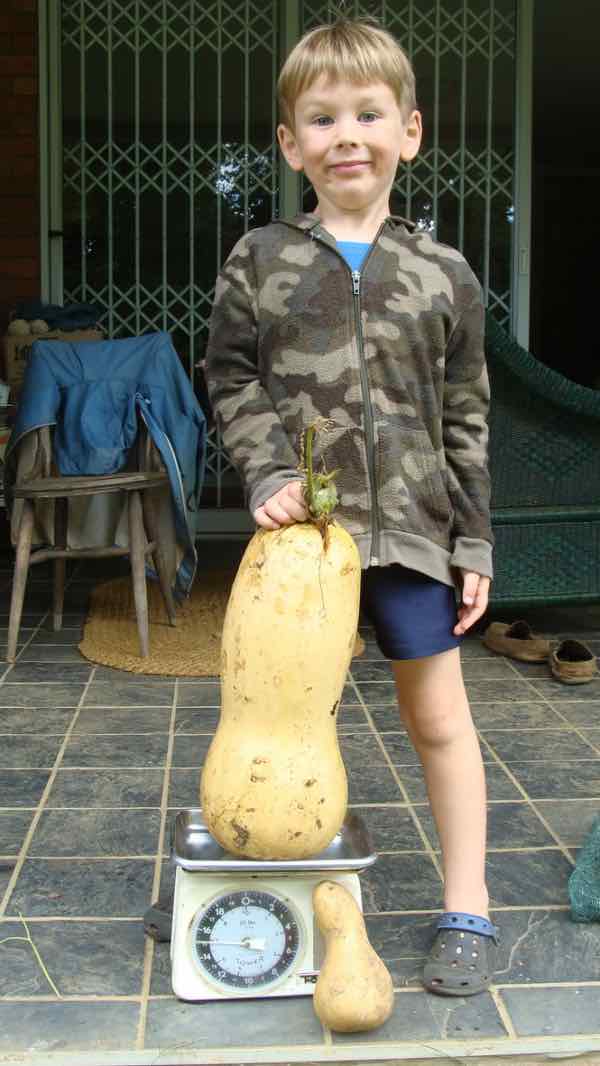
We still have small parts of our garden that have never been composted; see why growing butternut squash and in fact any vegetables is hopeless if you have not been getting your garden soil ready?
Since I wrote this page, a new fad diet, just as awful as all the others, known as banting, has been in vogue. Growing butternut squash is forbidden, certainly if you are planning to eat them. You too may be sucked into these pernicious diets, but once you understand the meaning of starch you will realise it is just another fad.
Diet is a dirty four letter word. Research shows that one year later only 5% have lost weight, and many have put on, across the whole spectrum of food manipulations.
It is not growing butternut squash, or new potatoes, and sweet potatoes that make us fat; it's french fries, chocolate cake and bagels.
Having come down heavily on banting, I will add one thing; if you cut out not all starch, but the refined carbohydrate, you will be infinitely stronger and will lose weight. I would rather get the extra fat that the proponents advocate from avocados and olive oil that butter, cream and bacon dripping.
Easy Butternut Squash Soup

Hand / stick blender
These are a must in every kitchen. It makes blending soups, sauces, hummus, grinding herbs and spices so much easier. The problem with the smaller motors (200W and less) is that they don't last. This one has a super duper 550W motor. Please give me feedback if you buy it. Our Braun works very nicely but expensive and not available on amazon. And it takes strain with the hummus.
Recipe for butternut squash soup
Simple after you've acqurired the skills that my four-year old grandchild has: Growing Butternut Squash ! Simply drop a seed in the ground! Better still in fertile ground if you want rich and prolific butternut.
- Best chicken bone broth recipe for stock.
- One roughly chopped large onion. (you're going to liquidise the whole)
- Cut the butternut into slices about two centimetres thick, and peel using a STRONG potato peeler. The hardest part of the whole exercise! You can of course avoid cutting yourself by getting someone else to hold the butternut whilst you chop it!
- Peel three large potatoes, or several smaller.
- Peel one sweet potato. Planting sweet potatoes .... like butternut so easy to grow.
Butternut squash soup recipes
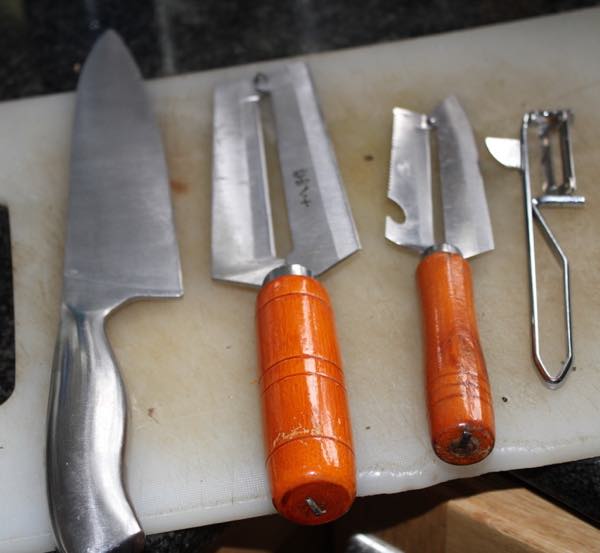
Now for the easy part!
Heat up a generous spoonful of butter in a large pot, and drop in the onions. Simmer on low heat, stirring frequently.
Butter? Raised cholesterol? Type OLIVE GARDEN NUTRITION into Site Search.
- Meanwhile peel and slice the veggies. Chuck them in with the onions as they are done, stirring.
- If you're a vegetarian, just pour in a few cups of boiling water, and simmer for about half an hour, until very tender. Or, strain in the chicken bone bouilon you've just made.
- Liquidise with a blender! We like it quite thick, so don't add too much water.
- Hey Preston, your recipe for butternut squash soup is done. Eat! Some people like to add various other herbs and spices, or coconut milk. The butternut has a gentle flavour, and I prefer it plain. A dollop of cream is nice, if you cholesterol is in order. Then take an after-dinner walk because exercise and cholesterol are strongly correlated. Inversely!
Absolutely never eat this supermarket butternut squash recipe.
Type "exercise and cholesterol" into Site Search in main menu above.
Omega-3 fatty acids
Why are we so crazy about our recipe for butternut squash soup? There are lots of reasons. Firstly, it just tastes fantastic. It is one of my all time favourite simple dishes. Must I say more?
But just as important,
perhaps more significant because I want to see my grandchildren growing
up are the added promised years from enjoying nutritious food. I have a lot to teach them about beekeeping, carpentry,
and gardening. My daughter mutters about leading them astray when I talk of motorcycles and gliders, but the bench saw is even more dangerous.
Newsletter
Our newsletter is entitled "create a cyan zone" at your home, preserving both yourself and Mother Earth for future generations; and the family too, of course. We promise not to spam you with daily emails promoting various products. You may get an occasional nudge to buy one of my books.
Here are the back issues.
- Lifestyle and ideal body weight
- What are ultra-processed foods?
- Investing in long-term health
- Diseases from plastic exposure
- Intensive lifestyle management for obesity has limited value
- A world largely devoid of Parkinson's Disease
- The impact of friendly bacteria in the tum on the prevention of cancer
- There's a hole in the bucket
- Everyone is talking about weight loss drugs
- Pull the sweet tooth
- If you suffer from heartburn plant a susu
- Refined maize meal and stunting
- Should agriculture and industry get priority for water and electricity?
- Nature is calling
- Mill your own flour
- Bake your own sourdough bread
- Microplastics from our water
- Alternative types of water storage
- Wear your clothes out
- Comfort foods
- Create a bee-friendly environment
- Go to bed slightly hungry
- Keep bees
- Blue zone folk are religious
- Reduce plastic waste
- Family is important
- What can go in compost?
- Grow broad beans for longevity
- Harvest and store sunshine
- Blue zone exercise
- Harvest and store your rainwater
- Create a cyan zone at your home
And Omega-3 is part of the reason why I have every hope that that is going to happen. You see, if you do not like fish, then you can still get these oils from butternut.
It contains 38mg of PUFA's, those are the fats that include Omega-3, not rich like in our mackerel recipes, but still good.
What is so special about Omega-3? They are a group of essential unsaturated fatty acids that your body cannot manufacture. You have to consume them if you want to be well. Amongst other things they have been proved to lower the bad cholesterol, LDL and VLDL, whilst raising the good HDL. Clean capillaries, more blood to the brain, the organs, to the heart itself, and your spine; more robust people. Walnuts and flaxseeds are good too.
Plus butternut is high in anti-oxidants like the carotenes (less malignant tumours), fibre (a happy colon) ... and you have to eat one heck of a lot to get fat, so you can pig out.
In fact, your winter squash has at least ten different carotenes. One of them, zeaxanthin is profoundly important in preventing macular degeration and cataracts.
In fact, it has a low glycemic index so does not give you an insulin rush.
So you see growing butternut squash does have certain benefits.
- MACKEREL RECIPES
- Flax seed nutrition information
- Broccoli walnut salad recipe
- What are phytosterols?
LACTATING MOTHERS
Lactating mothers must eat Omega-3 rich foods; fish, and of course butternut soup. Your child will be happier, calmer and more intelligent.
ALZHEIMER'S Disease
Say the researchers from the Dept of Psychiatry, University of Pittsburg: "Existing evidence links greater dietary intake of fish and flaxseed (Omega-3) to better early brain development and lowered risk of cognitive disorders in later life. Higher DHA was related to better performance on tests of nonverbal reasoning and mental flexibility, working memory, and vocabulary."
DHA is one of the omega-3 fatty acids.
To find interesting topics in bold, like those above, copy and paste them into the site search function in the main menu.
Fibre
Butternut is particular rich in fibre which makes up most of its starchy content; much of it is pectin which provides for a happy tum. It acts as a prebiotic for the teeming billions of good bugs in the colon.
It also makes passing the stool easier and helps prevent colo-rectal tumours.
Interestingly the pumpkin family in small amounts is recommended for the control of blood glucose in the management of diabetes.
Roasted butternut squash recipe
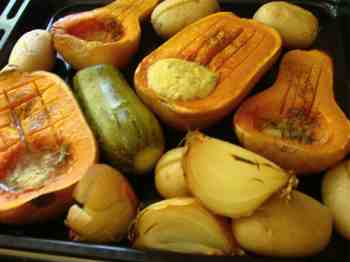
What I particularly like about this roasted butternut squash recipe, apart from the divine flavour, is that you don't have to peel it; that is surely the most tedious part about butternut; now it really is slow food, made fast. In fact, one hour start to finish to cook. Actually longer in the oven if it is a giant.
Thyme herb benefits is definitely something to consider along with your growing butternut squash; there should be a pot in every garden.
Two ways of enjoying butternut
Some cooks advocate eating butternut when they are very young; then you don't have to peel them which is a big advantage. However, I personally find them inspid.
Then you can wait another month or longer until they turn a deep nutty orange colour; they have much more flavour and can be stored for long periods through the winter.
Both ways of enjoying butternut squash I guess are good.
Did you find this page interesting? How about forwarding it to a friendly book or food junkie? Better still, a social media tick would help.
- Bernard Preston homepage
- Yellows
- Growing Butternut Squash
Address:
56 Groenekloof Rd,
Hilton, KZN
South Africa
Website:
https://www.bernard-preston.com